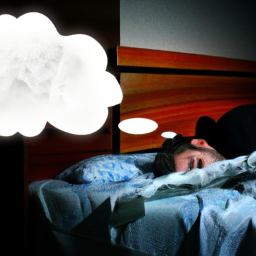As I lay in bed, my mind wanders off into a realm of boundless possibilities. Colors swirl before my eyes, sounds reverberate in my ears, and emotions flow through my veins. This is the vibrant dream state of slumber, a mystical realm where the subconscious reigns supreme.
But when does this enchanting state occur?
During the different stages of sleep, our minds undergo a remarkable journey. One particular stage, known as REM sleep, is where vivid dreams come to life. REM, or Rapid Eye Movement, is a fascinating phenomenon characterized by intense brain activity and rapid eye movements. It is during this stage that our dreams become vivid and lifelike, as if we are living in a parallel universe.
But what causes these vivid dreams? Scientists believe that a complex interplay of neural networks and biochemical processes contributes to their occurrence. Additionally, the quality of our sleep can greatly impact the intensity and frequency of these dreams.
In this article, we will explore the fascinating world of vivid dreams, uncover the mysteries behind their occurrence, and delve into the potential impact they may have on our mental health. So, let us embark on this journey together and unravel the secrets of the vivid dreams stage of sleep.
Key Takeaways
- Vivid dreams occur during REM sleep, which is characterized by intense brain activity and rapid eye movements.
- Disruptions in REM sleep can lead to sleep disorders such as REM sleep behavior disorder and nightmares.
- Strong emotions can heighten the vividness of dreams.
- Vivid dreams play a role in memory consolidation and help encode and retain important experiences and knowledge.
The Different Stages of Sleep
During the vivid dreams stage of sleep, our minds embark on a nocturnal journey through a kaleidoscope of fantastical realms. To understand this stage, it’s essential to comprehend the different stages of sleep and the importance of deep sleep.
Sleep cycles consist of several stages, each with its own unique characteristics. The first stage is light sleep, where we transition from wakefulness to sleep. As we progress into stage two, our brain waves slow down, and our body temperature decreases.
Stage three is deep sleep, which is crucial for our physical and mental restoration. During this stage, our body repairs itself, and our brain consolidates memories and learning. Finally, we enter the vivid dreams stage, also known as REM sleep. It’s characterized by rapid eye movements, increased brain activity, and intense dreams.
Understanding REM sleep is essential as it plays a vital role in emotional regulation, memory consolidation, and creativity. Transitioning into the subsequent section, it’s important to delve deeper into the mechanisms behind REM sleep and its significance in our sleep cycle.
Understanding REM Sleep
REM sleep, also known as the stage of slumber where our wildest imaginings come to life, is a fascinating and mysterious phenomenon. During this stage, our brain activity increases, and our eyes rapidly move back and forth, hence the name Rapid Eye Movement sleep.
It is during REM sleep that we experience vivid dreams, as our brain becomes highly active and creates a virtual reality within our minds. The benefits of REM sleep are numerous. It is believed to play a crucial role in memory consolidation, as it helps to strengthen and organize our memories. Additionally, REM sleep is vital for emotional regulation and processing, allowing us to cope with the ups and downs of daily life. It also supports learning and creativity, as it facilitates the integration of new information and the generation of novel ideas.
However, disruptions in REM sleep can lead to various sleep disorders. Conditions such as REM sleep behavior disorder involve acting out dreams physically, potentially causing harm to oneself or others. Nightmares, which are intense and disturbing dreams, can also disrupt REM sleep and contribute to sleep disturbances.
Understanding the intricate workings of REM sleep provides valuable insights into the complexity of our sleep architecture. Transitioning into the subsequent section about the brain activity during REM sleep, we explore the fascinating mechanisms that underlie this stage of slumber.
The Brain Activity During REM Sleep
As you enter the realm of REM sleep, your mind becomes a bustling city, with neurons firing like busy commuters rushing through the streets of your brain. During this stage, your brain activity is remarkably active, almost resembling the patterns seen when you’re awake. The brain waves during REM sleep are characterized by rapid, low-amplitude electrical activity, similar to beta waves. This heightened brain activity is crucial for the vivid dreams that occur during this stage.
To better understand the brain activity during REM sleep, let’s take a closer look at the different stages of sleep. Sleep is divided into two main categories: Non-REM (NREM) and REM sleep. NREM sleep consists of three stages, each with distinct brain wave patterns. Stage 1 is the transition from wakefulness to sleep, characterized by theta waves. Stage 2 is a period of light sleep, with the appearance of sleep spindles and K-complexes. Stage 3 is deep sleep, also known as slow-wave sleep, featuring delta waves.
The table below provides a summary of the different stages of sleep and their associated brain wave patterns:
| Stage of Sleep | Brain Wave Pattern |
|---|---|
| NREM Stage 1 | Theta waves |
| NREM Stage 2 | Sleep spindles and K-complexes |
| NREM Stage 3 | Delta waves |
| REM Sleep | Rapid, low-amplitude waves (similar to beta waves) |
Understanding the brain activity during REM sleep helps us delve into the fascinating world of vivid dreams. These dreams are believed to be caused by the interaction between this heightened brain activity and the processing of emotions and memories.
Transitioning into the subsequent section about ‘what causes vivid dreams,’ we can explore the factors that contribute to this intriguing phenomenon.
What Causes Vivid Dreams
One intriguing aspect of the dream experience is the exploration of what triggers these incredibly vivid and immersive nighttime journeys. To shed light on this phenomenon, let’s delve into the causes of vivid dreams.
Here are four factors that contribute to the occurrence of vivid dreams:
-
Neurotransmitter imbalance: Imbalances in neurotransmitters, such as serotonin and dopamine, can impact dream intensity. These chemicals play a crucial role in regulating mood and cognitive processes, including dreaming.
-
Emotional arousal: Strong emotions, whether positive or negative, can heighten the vividness of dreams. Stress, anxiety, excitement, and even happiness can all contribute to the intensity of dream experiences.
-
Sleep disorders: Conditions like sleep apnea, restless leg syndrome, and insomnia can disrupt the sleep cycle, leading to an increase in REM (rapid eye movement) sleep. As REM sleep is closely associated with dreaming, this can result in more vivid dream experiences.
-
Medications and substances: Certain medications, such as antidepressants and sleep aids, can influence dream vividness. Additionally, substances like alcohol and recreational drugs can also impact dream intensity.
Understanding the causes of vivid dreams is crucial for comprehending the relationship between dream experiences and sleep quality. Transitioning into the subsequent section, we’ll explore this connection in more detail.
The Relationship Between Vivid Dreams and Sleep Quality
To truly understand the connection between your dreams and the quality of your slumber, it’s important to delve into how deeply your mind journeys during its nightly adventures. Vivid dreams, which occur during the REM (rapid eye movement) stage of sleep, have been found to have a significant impact on creativity and the link between vivid dreams and subconscious thoughts.
During REM sleep, the brain becomes highly active, almost as if it is awake. This is when vivid dreams take place, as the brain generates complex images, emotions, and narratives. These dreams have been found to stimulate creativity, as they provide a platform for exploring new ideas and perspectives. Many artists, writers, and inventors have credited their vivid dreams for inspiring their most innovative works.
Additionally, vivid dreams offer a window into our subconscious thoughts. They can reflect our deepest fears, desires, and unresolved issues. By analyzing the symbols and themes in our dreams, we can gain insight into our own psyche and gain a better understanding of ourselves.
The impact of vivid dreams on creativity and the link between vivid dreams and subconscious thoughts are fascinating areas of study. Understanding these connections can offer valuable insights into the workings of the human mind. Transitioning into the next section, we will explore the role of vivid dreams in memory consolidation.
The Role of Vivid Dreams in Memory Consolidation
Explore the depths of your mind as it weaves together fragmented memories, creating a tapestry of experiences during your slumber. During the vivid dreams stage of sleep, our minds engage in a complex process known as memory consolidation. This process involves the integration of newly acquired information into our existing memory networks, helping us to encode and retain important experiences and knowledge.
One key aspect of this memory consolidation is the role of emotions in vivid dreams. Emotions play a crucial role in memory formation, and during the dreaming stage, our brains actively process and regulate these emotions. Studies have shown that emotional experiences are more likely to be remembered and incorporated into our long-term memory. Therefore, the emotional content of our dreams can have a significant impact on our overall dream recall and the subsequent impact on memory consolidation.
Dream recall itself is a fascinating phenomenon. Some individuals have a natural ability to remember their dreams in vivid detail, while others struggle to recall any dream content at all. The ability to recall dreams may be influenced by various factors, such as sleep quality, stress levels, and individual differences in brain activity during sleep.
As we delve deeper into the world of vivid dreams, we will now explore the common themes and symbols that frequently appear in these dreams, providing further insight into the intricate workings of our subconscious mind.
Common Themes and Symbols in Vivid Dreams
As we’ve explored the role of vivid dreams in memory consolidation, it’s fascinating to delve deeper into the common themes and symbols that often arise during this stage of sleep.
Dream researchers have identified several recurring motifs that can provide valuable insights into our subconscious mind. For example, falling is a common dream symbol that’s often associated with feelings of insecurity or a loss of control in one’s life.
Another prevalent theme is being chased, which may signify unresolved fears or anxieties. Additionally, flying dreams can represent a sense of freedom or empowerment. These dream symbols, among many others, serve as a window into our inner thoughts and emotions.
However, interpreting vivid dreams can be a complex task as they’re highly subjective and can vary from person to person. The key lies in understanding our own individual experiences and emotions. By analyzing the context and personal significance of these symbols, we can gain a deeper understanding of ourselves.
Moving forward, we’ll explore the intriguing phenomenon of lucid dreaming and how it allows us to take control of our vivid dreams.
Lucid Dreaming and Controlling Vivid Dreams
Lucid dreaming allows individuals to take control of their dreams and experience a sense of empowerment, but how exactly can we harness this ability? There are several techniques that can be used to achieve lucid dreaming and gain control over our vivid dreams.
-
Reality Checks: By regularly questioning our reality throughout the day, we can train our minds to do the same while dreaming. This increases the likelihood of recognizing when we are in a dream state.
-
Dream Journaling: Keeping a journal by our bedside and recording our dreams immediately upon waking can help improve dream recall. This heightened awareness of our dreams can make it easier to recognize when we are dreaming and take control.
-
Mnemonic Induction of Lucid Dreams (MILD): This technique involves setting an intention to remember that we are dreaming, and visualizing ourselves becoming lucid while repeating a phrase like "I’ll have a lucid dream tonight."
-
Wake-Back-to-Bed (WBTB): This technique involves waking up after a few hours of sleep, staying awake for a short period of time, and then going back to sleep. This can increase the chances of entering a lucid dream state.
By practicing these lucid dreaming techniques and dream control techniques, we can enhance our ability to take charge of our dreams and explore the vast possibilities they offer.
Transitioning into the next section, understanding the potential impact of vivid dreams on mental health is crucial for a comprehensive understanding of the dream world.
The Potential Impact of Vivid Dreams on Mental Health
Understanding the potential impact of intense dreams on mental health is crucial for gaining a comprehensive understanding of the dream world. The vivid dreams stage of sleep can have a significant impact on emotional well-being. Dreams often reflect our deepest desires, fears, and emotions, and experiencing intense dreams can evoke strong emotions that can affect our mental state upon waking.
These dreams can be vivid and realistic, leaving a lasting impression on our psyche.
Dream analysis can offer valuable insight into our subconscious mind and provide a deeper understanding of our emotions and experiences. By examining the symbols, themes, and emotions present in our dreams, we can gain valuable insights into our emotional well-being. This analysis can help identify unresolved issues, fears, or even provide solutions to problems we may be facing in our waking life.
The benefits of dream analysis extend beyond emotional well-being. It can also enhance creativity, problem-solving skills, and self-awareness. By delving into the hidden meanings and messages within our dreams, we can unlock a wealth of information that can positively impact our mental health.
Understanding the potential impact of vivid dreams and the benefits of dream analysis sets the stage for exploring tips for enhancing and remembering these intense dreams.
Tips for Enhancing and Remembering Vivid Dreams
To make your dreams more intense and memorable, try incorporating these simple tips into your nighttime routine.
First, establish a consistent sleep schedule to ensure you get enough sleep and increase the likelihood of entering the vivid dreaming stage.
Next, keep a dream journal by your bedside and write down any dream fragments or images you remember immediately upon waking. This practice enhances dream recall over time, allowing you to better analyze and interpret your dreams.
Additionally, practicing reality checks throughout the day can help facilitate lucid dreaming. This involves questioning whether you’re dreaming or awake by examining your surroundings and performing simple tests, such as trying to push your finger through your palm. By incorporating reality checks into your daily routine, you increase the chances of becoming aware that you’re dreaming while in a dream.
Finally, creating a relaxing bedtime routine, free from electronic devices and stimulating activities, can promote a more restful sleep and enhance the likelihood of vivid dreaming.
By implementing these techniques for lucid dreaming and enhancing dream recall, you can unlock the full potential of your dream world and gain valuable insights into your subconscious mind.
Frequently Asked Questions
Can vivid dreams occur during any stage of sleep?
Vivid dreams and dream recall can occur during any stage of sleep. However, the likelihood of experiencing lucid dreaming, where one is aware that they’re dreaming, is higher during REM (rapid eye movement) sleep. This is because REM sleep is characterized by increased brain activity and vivid dreaming.nnDuring this stage, the brain is more active, and therefore, the dreams can be more memorable and intense.
How long do vivid dreams typically last?
Vivid dreams typically last for a short duration during sleep. They can occur multiple times throughout the night, especially during REM (Rapid Eye Movement) sleep.
The frequency and duration of these dreams can vary from person to person. While some may experience vivid dreams regularly and remember them vividly, others may have less frequent or less memorable dreams.
The exact reasons for the duration and frequency of vivid dreams are still being studied by sleep researchers.
Are there any factors that can prevent someone from experiencing vivid dreams?
It’s absolutely fascinating how some individuals have the rare ability to prevent vivid dreams altogether. As for the rest of us mere mortals, there are a few factors that can impact our dream intensity.
One major culprit is certain medications, such as antidepressants and beta blockers, which can suppress the vividness of our nocturnal adventures. So, if you’re looking to keep those dreams dull and uneventful, just pop a pill and bid farewell to the whimsical wonders of the subconscious mind.
Can vivid dreams be a sign of a sleep disorder?
Vivid dreams can indeed be a sign of a sleep disorder. Sleep disorders such as REM sleep behavior disorder (RBD) can cause intense and vivid dreaming. RBD is characterized by the absence of muscle paralysis during REM sleep, leading to acting out dreams physically. This disorder can have psychological implications, as it can result in injuries or harm to oneself or others. Seeking professional help is crucial to diagnose and treat sleep disorders that manifest through vivid dreaming.
Are there any methods for reducing the occurrence of vivid dreams?
There are several methods for reducing the occurrence of vivid dreams. One technique is practicing relaxation exercises, such as deep breathing or meditation, before bedtime.
Another method is to establish a consistent sleep schedule and create a calming bedtime routine.
Avoiding stimulating substances like caffeine or alcohol close to bedtime can also help manage intense dreams.
Additionally, keeping a dream journal and discussing any unresolved emotions or stress with a therapist may provide further relief.
Conclusion
In conclusion, the vivid dreams stage of sleep, also known as REM sleep, is a fascinating phenomenon that occurs during certain periods of the night.
This stage is characterized by intense brain activity and is responsible for the occurrence of vivid dreams. While the exact cause of these dreams is still not fully understood, researchers believe it’s linked to memory consolidation and emotional processing.
Additionally, the quality of sleep can greatly impact the occurrence of vivid dreams.
By understanding the science behind vivid dreams, we can potentially enhance and remember them more effectively.
Sleep tight and let your dreams take flight!










